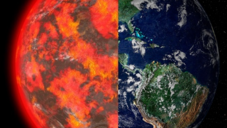Universal Model of the Density of Deep Silicate Melts | Glass2Melt

How did the Earth evolve from its initial largely molten state to its current mostly solid state?
The density of silicate melts plays a crucial role in shaping Earth’s evolution and mantle dynamics, influencing whether crystallizing materials rise or sink, as well as controlling melt distribution and migration. However, measuring these densities under high pressure and temperature conditions representative of the mantle has been extremely difficult owing to tiny sample sizes, chemical reactivity and the lack of crystalline structure. The ERC-funded Glass2Melt project will leverage a novel class of white laser spectroscopy methods to probe the density of synthetic silicate glasses and melts across a wide compositional range and at pressure-temperature conditions ranging from the Earth's crust to its core. Our approach will inform a universal density model describing silicate melts, providing insights into magma ocean solidification, mantle heterogeneity, seismic velocity structures and magma behavior in modern Earth.
Time frame
- 01.06.2024 -31.05.2029
Principal Investigator
- Sergey Lobanov (GFZ)
Stuff
- I. Veksler (GFZ)
- X. Li (GFZ)
- K. Solovev (GFZ)
Funding
- ERC
Research Unit(s) (POF/MESI/GIPP)
Cooperation/Partner
- Dr. S. Speziale (GFZ)
- Prof. Dr. Le Losq (IPGP)
- Prof. Dr. S. Brune (GFZ)
- Prof. Dr. M. Nakajima (University of Rochester)
- Prof. Dr. B. Winkler (Goethe University, Frankfurt on Main)
- Prof. Dr. C. Sanchez-Valle (Westfälische Wilhelms-Universität Münster)
- Prof. Dr. T. Katsura (BGI, University of Bayreuth)